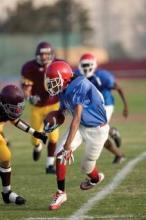Greater awareness of the potential long-term sequelae from multiple concussions has prompted nearly two-thirds of states to pass legislation that is meant to protect athletes suspected of having a concussion.
These laws are spurring wider use of concussion screening tests and educational materials to inform coaches, parents, athletes, and medical professionals of the importance of identifying players suspected of having a concussion and getting them evaluated before they can return to play. Studies also are underway or being planned to determine how the risk of concussion varies among individuals and how it is influenced by the number and severity of blows to the head.
Since the enactment of the Lystedt Law in Washington in 2009, 29 other states and the District of Columbia have passed similar laws, and an additional state has a bill that at press time awaited the governor’s signature for final passage into law, according to NFL Health & Safety. In general, the laws require that athletes suspected of having a concussion be held out of games or practice until they have been evaluated and cleared to return by a trained and licensed health care provider, whose definition varies across states.
These developments are driving a change in attitude toward how concussions are evaluated and managed at all levels of sports, both in practice and on the field. "What we’re starting to see is organizations taking a look at practice parameters, [such as] limiting the amount of contact that can happen in the practice environment," said Dr. Jeffrey S. Kutcher, director of the University of Michigan’s Neurosport Program. He noted that this year the Ivy League conference became the first to limit the amount of contact that players have during practice sessions.
Return to play is now being more widely regarded as a medical decision that must be made by qualified health care providers. In a position paper last year, the American Academy of Neurology (AAN) said that return-to-play decisions should be made by a neurologist or a physician with training in the evaluation and management of sports concussion. It also called for certified athletic trainers to be present at all sporting events and practices at which athletes are at risk of concussion.
Recognizing Concussion in Youth Athletes
But while professional sports teams and universities can provide physicians or athletic trainers to screen for and diagnose concussion, youth athletes most often won’t have those resources available. They need people trained to screen for concussion and pull them out of play until they can be evaluated by a licensed health care provider.
"[High] schools are not going to have a physician on the field," Dr. H. Hunt Batjer, professor and chair of neurological surgery at Northwestern University, Chicago, said in an interview. In the metro Chicago area, "many do not have close affiliation with a trainer. Somebody is going to have to take on that role of identifying a concussed athlete. Ideally, it would not be the coach. Ideally, it would be a health professional."
To help youth and high school coaches – as well as athletes and parents – recognize the signs of concussion and know what to do to if a player gets a head injury, the AAN is offering two free, online, 20-minute safety courses created by the University of Michigan’s Neurosport Program. Free downloadable cards that describe how to spot concussion and what to do if one occurs also are available on the academy’s website.
How to Evaluate Concussion
There are at least 16 different grading systems that attempt to measure severity of traumatic brain injury (TBI), the most recent about 10 years old, according to Dr. Michael A. Lobatz, a neurologist and the medical director at the Scripps Rehabilitation Center, Encinitas, Calif.
However, the AAN is developing a new grading system that "will probably be published by November of this year. That will be very useful and most updated based on class I evidence," noted Dr. Lobatz, who spoke at a meeting on primary care medicine sponsored by the Scripps Clinic.
Older grading systems do not properly prognosticate the severity of the concussion and duration of symptoms. They also fail to appreciate the sensitivity of children and adolescents to concussion, who are at higher risk than adults are for second-impact syndrome, and they are slower to recover than adults, Dr. Richard Ellenbogen, professor and chair of neurological surgery at the University of Washington, Seattle, said in an interview.



